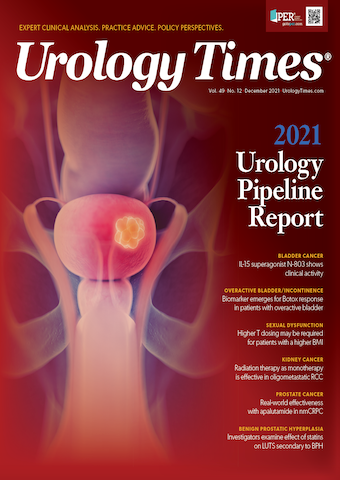Publication
Article
Urology Times Journal
How the 2022 CMS final rule will affect urologists
Author(s):
Jonathan Rubenstein, MD

In July 2021, the Centers for Medicare & Medicaid Services (CMS) released its proposed rules for the Medicare Physician Fee Schedule (MPFS) and for the Hospital Outpatient Prospective Payment System and Ambulatory Surgical Center (OPPS/ASC) Payment System. We had discussed this and our thoughts on these proposed rules in our August 2021 column.1 Societies and interested parties were able to provide their thoughts on the proposed rules to CMS during the comment period. The biggest impacts on urology involved the proposed reduction in the conversion factor (CF) and the effect of updated clinical labor rates on nonfacility-based procedures. On November 2, 2021, CMS released its final rules for the MPFS and OPPS/ASC Payment System outlining the policies to be implemented on January 1, 2022. Despite comments from interested parties hoping for changes, CMS adopted much of what had been proposed in July.
Financial impact
Mark Painter

The CF for 2022 is scheduled to be $33.5983, a decrease of 3.71% from the current $34.8931. This decrease is primarily due to the expiration of a 1-time contribution from the trust fund as directed by one part of the of the Consolidated Appropriations Act of December 2020, which raised the CF by 3.75% for the 2021 calendar year only. This reduction will directly affect payment for work performed by providers for patients covered by Medicare and Medicare Advantage plans. The relative value unit (RVU) changes overall are projected as a 0.0% impact based on the full volume of services for the specialty code payments. Taken in combination, this means that urology as a specialty will see a 3.71% decrease in overall payments in 2022 despite providing the same volume of services. The impact will not be equal for all urologists based upon their practice patterns and case mix.
As noted in our August 2021 article, clinical labor rates had not been updated in nearly 2 decades but were proposed to be updated for 2022. The concern was that these rates would dramatically increase due to being nearly 2 decades behind and, when plugged into a budget-neutral system, would lead to significant shifts in the reimbursement for practice expenses. The net effect of a significant shift would benefit services with high clinical labor rates but would adversely affect the reimbursement for services with low clinical labor yet high expenses, such as nonfacility-based surgical procedures, especially those with high device or nonlabor practice expense.
Because of this, there was a push by many to have CMS delay the implementation of this change for at least 1 year while the true effects could be further studied, and/or to implement a device offset for the device-intensive procedures. Unfortunately, neither of these asks were accepted by CMS in the final rule. However, the final rule did allow a 4-year phase-in of the updated clinical labor rates, which would let practices adjust to this change. In addition, CMS will use the median Bureau of Labor Statistics (BLS) wage data instead of the mean wage data, and the 2021 BLS fringe benefits multiplier of 1.296 as opposed to the 2002 BLS fringe benefits multiplier of 1.366. These changes will help mitigate the sudden and significant change to urology practices, at least in the short run. Practices will need to evaluate how this affects them both for 2022 and for years to come.
As noted above, the RVU changes for 2022 when adjusted for volume across all urologists are projected to be 0%. The global look at RVU changes does not tell the entire story and will not apply equally to all urologists. Only 11 codes with modifiers remained unchanged in total values for the Urology CPT section. Taking all RVU adjustments into account, most CPT codes in the Urology CPT section have slightly increased. The high volume of the negatively adjusted CPT codes offset the small increases for those positive RVU adjustments. Physician payments in the facility setting did not see many RVU changes. No codes in the range increased by greater than 3.71%. CMany urology practices also must contend with decreases in fees associated with radiology and radiation oncology decreases due to RVU decreases on top of the CF decrease. For those groups with ambulatory surgical centers, the changes in code payment structure were limited and the overall payment was increased by approximately 2.0% for most services.
For the OPPS and ASC Payment System, CMS is increasing payment by a factor of 2.3%. Hospitals and ASCs that fail to meet their respective quality reporting program requirements are subject to a 2.0% reduction in the calendar year 2022 fee schedule increase factor, in continuation of existing policy.
Quality Payment Program changes
For calendar year 2022, CMS will require clinicians to meet a higher performance threshold to be eligible for incentives following threshold requirements established for the Quality Payment Program’s Merit-based Incentive Payment System (MIPS) under the Medicare Access and CHIP Reauthorization Act of 2015. 2022 is the last performance year in which CMS will provide additional funds for exceptional performance; CMS will in future years only use penalties to fund bonus payments for exceptional performance. The threshold score for 2022 performance will be 75 with 30% of the score assigned to Quality and Cost categories, 25% to Promoting Interoperability, and 15% for Improvement Activities.
Evaluation and management changes
Split/shared visits are those where the service is provided in part by both the physician and non-physician practitioner (NPP) of the same group.While prior guidance was interpreted as limiting split/shared billing to established patients and not allowing critical care services to be split/shared, in 2022 CMS will change its policy and permit physicians and NPPs to bill for split/shared visits for both new and established patients and also for critical care services. Historically, the billing provider could be the physician if performing a “substantive portion” of the visit.CMS had proposed to allow billing by the practitioner who performed > 50% of the time of the service and would allow split/shared billing based upon time.In the Final Rule, there will be a 1-year transition period for this to take place, so during 2022 split/shared billing can be based upon time or medical decision-making using one of three key components of the visit (history, exam or medical decision-making) to qualify as the “substantive portion” of the visit. If performing a key component of the visit is utilized, the practitioner who bills the visit must perform and document the performance of that component in its entirety. For critical care services, which are time-based codes already, the physician or NPP must provide more than half of the total time in order to bill for the visit.
In the office setting, Shared/Split visits will not be allowed. CMS will continue to recognize “incident to” rules to determine how to classify services provided in the office setting. No changes were made to the “incident to” rules. We have seen many practices struggle with “incident to” billing for advanced practice providers (APPs). It is worth reviewing these guidelines and your practice’s policies every year. CMS also stated that Medicare will not recognize modifier -52 with E/M codes.
APPs
CMS is also finalizing the proposal to allow physician assistants (PAs) to directly participate in the Medicare program. Previously, a PA had to be contracted or employed by another qualified Medicare entity to bill Medicare. These changes in PA status are reflective of the growing contribution PAs make in the United States market regarding access to care and the increase in the team approach to health care. State licensure requirements must be met regarding supervision to qualify for participation in the Medicare program.
Telehealth
As we have stated previously, Medicare does not have the legislative power to open telehealth provided to patients outside of a Medicare-approved facility once the public health emergency (PHE) for COVID-19 expires. Although the current PHE is scheduled to expire January 15, 2022, based upon the time this article was written, this is reevaluated every 90 days, and it is possible or likely that this will be renewed again. In the final rule, Medicare included all codes from Categories 2 and 3 as covered services under telehealth rules until 2023 or the end of the calendar year in which the COVID-19 PHE expires, whichever is later (please refer again to our August 2021 article for further information).
After the PHE expires, CMS will no longer cover codes 99441-99443 (telephone only) visits but will revert to codes G2250-G2253 for virtual check-in visits and the codes for virtual management for nontelehealth remote visits. There are no proposed changes to rules for use of these codes. Once the PHE ends, you will need to review requirements for use of these codes if there is no legislative change to telehealth. CMS finalized the value for code G2252 at the same level as 99442.
CMS finalized its proposed rules for expanding coverage for remote treatment of patients based on a series of new codes to be added to CPT for remote therapeutic monitoring. These codes do not require the same number of days within a month that the patient remote monitoring codes require, filling a hole in the coding structure. Currently available remote monitoring codes require 16 days of monitoring within a month. The new remote therapeutic monitoring codes with few exceptions allow for medically appropriate number of days within the month for reporting purposes. The current focus of the codes appear to have limited application in urology, we will continue to review the codes and their appropriate use.CMS also indicated it will continue to engage in discussions with the American Medical Association and other concerned entities to expand access to care through remote services.
Changes to the Inpatient Only list
CMS created and maintained an Inpatient Only (IPO) list, which includes services Medicare will only pay for when performed in an inpatient setting because of their medical complexity. In the final rule for 2021, CMS decided to eliminate the IPO list over a 3-year period, with 298 services to be removed initially. However, CMS received numerous stakeholder comments opposing elimination of the IPO list mainly over patient safety issues. In the final rule for 2022, CMS halted the elimination of the IPO list and restored to the list the services removed in 2021, except for a few orthopedic codes. Procedures can still be removed from the IPO list if deemed appropriate based on Medicare criteria.2
Changes to the ASC Covered Procedures List
Similar to the IPO list, in the 2021 final rule CMS added 267 surgical procedures to the ASC Covered Procedures List (CPL) beginning in 2021. However, CMS is restoring criteria for adding procedures to the ASC CPL that were there in calendar year 2020. Procedures can be added to the ASC CPL if they meet Medicare’s criteria. Three codes were proposed initially for removal and are being retained, including 2 urology CPT codes: 0499T (cystourethroscopy, with mechanical dilation and urethral therapeutic drug delivery for urethral stricture or stenosis, including fluoroscopy, when performed) and 54650 (orchiopexy, abdominal approach, for intra-abdominal testis [eg, Fowler-Stephens]). Also in the works is adoption of a nomination process, to begin in March 2022, to let external parties nominate surgical procedures to be added to the ASC CPL.2
Appropriate Use Criteria program pushed back again
The somewhat controversial Appropriate Use Criteria program has been postponed again. Previously, the payment penalty phase of the program was to begin January 1, 2022. However, CMS now will not begin that phase until at least January 1, 2023, or the January 1 following the declared end of the PHE for COVID-19. This flexible effective date is intended to consider the impact that the PHE for COVID-19 has on practitioners, providers, and beneficiaries.
Conclusions
Based on the current path of Medicare and the MIPS/MACRA program revisions, it is hard not to feel déjà vu to the days of the sustainable growth rate when yearly patches were provided to maintain physician payment. Although there are efforts to avert the CF cut, we are hopeful but not convinced that Congress will take the action necessary to truly adjust the Medicare budgeting process to avoid the projected decreases in reimbursement as physician groups face increasing costs and administrative burdens. It will take the collective support of physicians and patients to initiate change to this now-outdated approach.
References
1. Rubenstein J, Painter M. 2022 CMS proposed rule represents another mixed bag for urologists. Urology Times®. August 5, 2021. Accessed November 11, 2021. https://bit.ly/3ou4XT4
2. CY 2022 Medicare Hospital Outpatient Prospective Payment System and Ambulatory Surgical Center Payment System Final Rule (CMS-1753FC). News release. Centers for Medicare & Medicaid Services. November 2, 2021. Accessed November 10, 2021. https://go.cms.gov/3qFupI2
Send coding and reimbursement questions to Rubenstein and Painter c/o Urology Times®, at UTeditors@mjhlifesciences.com.
Questions of general interest will be chosen for publication. The information in this column is designed to be authoritative, and every effort has been made to ensure its accuracy at the time it was written. However, readers are encouraged to check with their individual carrier or private payers for updates and to confirm that this information conforms to their specific rules.

Newsletter
Stay current with the latest urology news and practice-changing insights — sign up now for the essential updates every urologist needs.































